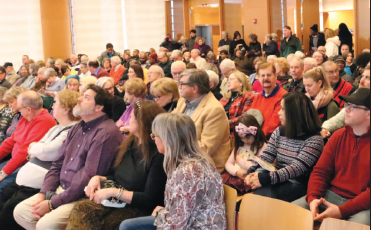National Commentary
Overflow Crowd Attends Slover Lecture On Jefferson’s Black Daughter

NORFOLK
An overflow crowd was on hand Sunday, Jan. 27 at the Slover Library in downtown Norfolk to hear Dr. Catherine Kerrison discuss her latest book, “Jefferson’s Daughters: Three Sisters, White and Black, in A Young America.” Kerrison is an associate professor of history at Villanova University, where she teaches courses in colonial and revolutionary America and women’s and gender history.
The event was the second of three lectures in the Catherine Lee Brinkley Memorial Lecture Series being offered by the Slover Library to “keep the spirit of community discourse about current events alive and to celebrate recently published books of national note.” It is being sponsored by Jane Batten, who was in attendance, as was former Mayor Paul Fraim, who heads the Slover Library Foundation.
Kerrison’s expert re-search and writing on Virginia’s Thomas Jefferson, the primary writer of the Declaration of Independence, and the third president of the United States, may have added to the crowd’s interest. Certainly, the sexual liaison between Jefferson and his enslaved companion Sally Hemings has been a topic of discussion and controversy since the relationship was disclosed several years ago.
Kerrison’s book reveals much about the lives of Jefferson’s two white daughters, Martha and Maria, and the third, Harriet, the biracial product of his long-time relationship with the enslaved Sally Hemings.
Sally also gave birth to three sons by Jefferson: William Beverly in 1798; James Madison in 1805; and Thaddeus Eston in 1808.
Forty-two years ago, when the relationship between Thomas Jefferson and Sally Hemings was first exposed, historians and other deniers lambasted Fawn Brodie for revealing Jefferson’s sexual ex-ploiting and siring of children with slave Sally Hemings.
In the biography, “Thomas Jefferson: An Intimate History,” Brodie’s research unraveled the connection between the family of the nation’s third president, and the biracial extended clan he, and perhaps other relationships, fostered.
Although there is con-siderably more information about Martha and Maria, Kerrison said the life of Harriet was a puzzle with pieces secured from a variety of writings from her half-sisters, Jefferson’s sketchy notations, and Harriet’s younger brother..
Several chapters of Kerrison’s book cover the life of Harriet from age 14 to 21, when she was put to work on a spinning jenny in a textile mill located on the Monticello plantation.
When Harriett was 21, Jefferson made good on freeing Harriet, according to Kerrison.
Kerrison said after Harriet left the plantation, she disconnects from her family. According to a newspaper interview given years later by her younger brother, Madison, she begins a new life passing for white and marrying a white man in Washington, D.C.
Kerrison detailed her lengthy research efforts to uncover Harriet’s identity as a white woman.
The final lecture in the series in April 3, 2019.










